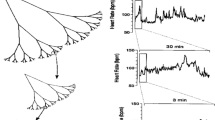Abstract
The electrogastrogram (EGG) is a surface measurement of gastric myoelectrical activity. The normal frequency of gastric myoelectrical activity in humans is 3 cycles/min. Abnormal frequencies in gastric myoelectrical activity have been found to be associated with functional disorders of the stomach. The aim of this article was, therefore, to develop new time-frequency analysis methods for the detection of gastric dysrhythmia from the EGG. A concept of overcomplete signal representation was used. Two algorithms were proposed for the optimization of the overcomplete signal representation. One was a fast algorithm of matching pursuit and the other was based on an evolutionary program. Computer simulations were performed to compare the performance of the proposed methods in comparison with existing time-frequency analysis methods. It was found that the proposed algorithms provide higher frequency resolution than the short time Fourier transform and Wigner-Ville distribution methods. The practical application of the developed methods to the EGG is also presented. It was concluded that these methods are well suited for the time-frequency analysis of the EGG and may also be applicable to the time-frequency analysis of other biomedical signals. © 1998 Biomedical Engineering Society.
PAC98: 8780+s, 0705Kf
Similar content being viewed by others
REFERENCES
Abell, T. L., and J. R. Malagelada. Electrogastrography: Current assessment and future perspectives. Dig. Dis. Sci.33:982-992, 1988.
Back, T., and H. P. Schwefel. An overview of evolutionary algorithm for parameter optimization. Evolut. Comput.1:1- 23, 1993.
Chen, J. D. Z., J. Vandewalle, W. Sansen, G. Vantrappen, et al.Adaptive spectral analysis of cutaneous electrogastric signals using autoregressive moving average modeling. Med. Biol. Eng. Comput.28:531-536, 1990.
Chen, J. D. Z., and W. McCallum. Clinical applications of electrogastrography. Am J. Gastroenterol.88:1324-1336, 1993.
Chen, J. D. Z., W. R. Stewart, and R. W. McCallum. Adaptive spectral analysis of episodic rhythmic variations in the cutaneous electrogastrogram. IEEE Trans. Biomed. Eng.40:128-135, 1993.
Chen, J. D. Z., R. Richards, and R. W. McCallum. Frequency components of the electrogastrogram and their correlation with gastrointestinal motility. Med. Biol. Eng. Comput.31:60-67, 1993.
Chen, J. D. Z., and Z. Lin. Comparison of adaptive filtering in time-, transform-and frequency-domain: An electrogastrographic study. Ann. Biomed. Eng.22:423-431, 1994.
Chen, J. D. Z., and W. McCallum. Electrogastrography: Principles and applications. New York: Raven, 1994.
Classen, T. A. C. M., and W. F. G. Mecklenbrauker. The Wigner distribution-A tool for time-frequency signal analysis-Part III: Relations with other time-frequency signal transformations. Philips J. Res.35:372-389, 1980.
Coifman, R. R., and M. V. Wickerhauser. Entropy-based algorithms for best-basis selection. IEEE Trans. Inf. Theory38:713-718, 1992.
Dubois, A. Gastric dysrhythmias: Pathophysiological and etiologic factors. Mayo Clin. Proc.64:246-250, 1989.
Fogel, D. An introduction to simulated evolutionary optimization. IEEE Trans. Neural Netw.5:3-14, 1994.
Fogel, L. J., D. B. Fogel, and P. J. Angeline. A preliminary investigation on extending evolutionary programming to include self-adaptation on finite state machines. Informatica18:387-398, 1994.
Friedman, J. H., and J. W. Tukey. A projection pursuit algorithm for exploratory data analysis. IEEE Trans. Comput.C-23:881-889, 1974.
Friedman, J. H. Exploratory projection pursuit. J. Am. Stat. Assoc.82:249-266, 1987.
Geldof, H., E. J. van der Schee, M. Van Blankenstein, and J. L. Grashius. Electrogastrographic study of gastric myoelectrical activity in patients with unexplained nausea and vomiting. Gut26:799-808, 1986.
Hasler, W. L., H. C. Soudah, G. Dulai, and C. Owyang. Mediation of hyperglycemia-evoked gastric slow wave dysrhythmias by endogenous prostaglandin. Gastroenterology108:727-736, 1995.
Hubert, P. J. Projection Pursuit. Ann. Statist.13:435-475, 1985.
Koch, K. L., R. M. Stern, and M. Vasey, et al.Gastric dysrhythmias and nausea of pregnancy. Dig. Dis. Sci.35:961-968, 1990.
Lin, Z. Y., and J. D. Z. Chen. Time-frequency representation of the electrogastrogram-Application of the exponential distribution. IEEE Trans. Biomed. Eng.41:267-275, 1994.
Mallat, S. S., and Z. Zhang. Matching pursuit in a timefrequency dictionary. IEEE Trans. Signal Process.41:3397- 3415, 1993.
Mintchev, M. P., Y. J. Kingma, and K. L. Bowes. Accuracy of cutaneous recordings of gastric electrical activity. Gastroenterology104:1273-1280, 1993.
Smout, A. J. P. M., E. J. van der Schee, and J. L. Grashuis. What is measured in electrogastrography? Dig. Dis. Sci.25:179-187, 1980.
van der Schee, E. J., and J. L. Grashuis. Running spectrum analysis as an aid in the representation and interpretation of electrogastrographic signals. Med. Biol. Eng. Comput.25:57- 62, 1987.
Yao, X., and Y. Liu. Evolving artificial neural networks for medical applications. Proceedings of the First Korea-Australia Joint Workshop on Evolutionary Computation, Taejon, Korea, 27-29 September 1995, pp. 1-16.
Author information
Authors and Affiliations
Rights and permissions
About this article
Cite this article
Wang, Z., He, Z. & Chen, J.D.Z. Optimized Overcomplete Signal Representation and its Applications to Time-frequency Analysis of Electrogastrogram. Annals of Biomedical Engineering 26, 859–869 (1998). https://doi.org/10.1114/1.69
Issue Date:
DOI: https://doi.org/10.1114/1.69




